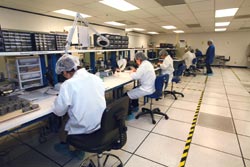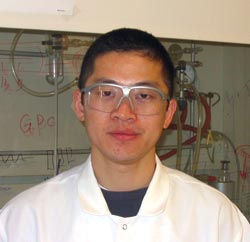Through the years, a variety of forces have compelled the US government to place restrictions on immigration and on visas issued to scientists and other workers from foreign nations: the Cold War, threats of terrorism, economic protectionism.
In still other cases, as with a recent measure designed to limit hiring of foreign workers by financial services firms that receive government assistance, officials might be playing to populist outrage over a tattered economy and to longstanding fears of immigrants taking jobs from American wage earners.

Fremont, Calif.-based BaySpec Inc. said that it hires US workers whenever possible, in part because sponsoring foreign nationals for H-1B visas can be a difficult process. At times, however, it has brought in foreign workers for high-tech jobs, stating that there are no qualified workers otherwise.
Continued progress in science and technology is crucial to any attempt to repair the economy. Some experts say that foreign investigators are essential to keeping this machine going. Moreover, the US is no longer an unchallenged superpower in these areas, where other countries are developing competitive “innovation economies” and aggressively courting scientists and technologists worldwide. Thus, our own fortunes as a nation are tied up with those of researchers whose status, it seems, is frequently in question.
Visa issues have been in the news lately as foreign researchers and students hoping to enter or re-enter the US have faced sometimes months-long delays in obtaining the document. Such delays were last reported in the wake of the Sept. 11 attacks, almost eight years ago, as officials instituted and attempted to navigate myriad new policies involving background checks – many of them spelled out in the USA Patriot Act, the antiterrorism law passed in the months after the attacks. Even then, however, it was not long before visa and visa renewal times were down again, to about two weeks.
Delays and challenges
In the past year, researchers and students again have been experiencing delays. A New York Times article published in March reported that students from around the globe – including the European Union and Australia – were facing difficulties, but that those from China, India, the Middle East and Russia appeared to have encountered the most Sisyphean of challenges.
Sources say that researchers are finding themselves unable to re-enter the US after visiting family abroad, for example, because their documents have disappeared into a bureaucratic maze, and embassy employees are either unable or unwilling to locate them, much less process them in a timely manner.
Meanwhile, back in the States, research projects are stalling and, in some cases, falling apart as the investigators wait for months at a time, calling, e-mailing and even visiting the US Embassy daily in the increasingly vain hope of getting back to work.
It is not clear what is causing these delays, or why they appear to have become more prevalent in the past year. The Times article quotes a US Department of State official who, speaking on condition of anonymity, confirmed that those seeking visas often have to wait two or three months. The same official attributed the delays simply to “an unfortunate staffing shortage.”
Many have decided not to wait any longer. Anecdotal evidence suggests that tens of thousands of Chinese and Indian workers have returned home, finding greater opportunities – and fewer headaches – in those burgeoning economies. A recent study by Duke University professor and Harvard researcher Vivek Wadhwa found that as many as 100,000 workers could go back to each of these countries in the next three to five years.
Others are staying on, but making sacrifices to do so. Jinda Fan, a chemist working in an optical imaging lab at Washington University in St. Louis, was delayed for several weeks last year when he visited his parents in China. Because of this experience, he said, he “probably won’t risk” going to China again until he has applied for and received a green card – easily years from now – or until he decides to return there permanently.

Jinda Fan, a chemist who helps develop contrast agents for biomedical imaging, was delayed for several weeks when he visited his parents in China last summer – the background security check took longer than he was told it would when he applied for a return visa, the day after arriving in Beijing.
Fan gives voice to the frustration that many foreign researchers and students feel. Because they are not US citizens, he explains, they cannot participate in the electoral process, and, thus, have no say in whether or how the problem is addressed. Those who have that right, however, do not have the problem.
“That is why this hasn’t improved,” he said.
Getting a foot in the door
Another difficulty that foreign researchers have in obtaining work visas is that the company hiring a researcher needs to sponsor his or her application, a process that can involve a significant investment of time and money. As a result, many companies hire only green card holders and citizens; some state explicitly that they do not sponsor foreign researchers for work visas. This effectively reduces the number of positions open to the researchers.
Also, the number of H-1B work visas issued to professionals seeking employment in private industry is capped by US Citizen and Immigration Services (USCIS) and has been dropping in recent years. But the quota adjustment is reasonable, as it has been keeping pace with the economy, said William Yang, CEO and president of BaySpec Inc. of Fremont, Calif., which manufactures and markets fiber optic components, modules and subsystems.
Finally, the USCIS accepts only H-1B petitions beginning on April 1, and in most cases, if approved, the researcher cannot begin working until Oct. 1 – the start of the fiscal year. “So you have to be really careful about the timing,” said Ivan Teng, a programmer/analyst in the department of neurosciences at the University of California, San Diego, in La Jolla. “If you are not able to get sponsorship, then you’ll have to wait another year – if you can.”
Teng entered the US with an F-1 student visa in 2001 to attend graduate school for electrical engineering. After graduating, he said, he struggled to find work in private industry; for the reasons outlined above, he was unable to land a job. He then focused on educational institutions, which are “quota exempt” – applications from such institutions do not count toward the H-1B quota set by the USCIS and can be submitted anytime during the year.
Because of the difficulty in advancing his career, however, Teng now is planning to return to either Taiwan or New Zealand, where he holds dual citizenship. “The issue with work visas and green cards has definitely made me rethink my career plan,” he said. “I think it is holding me back.” The university he works for does not sponsor green card applications for employees with his job title, he explained, and the H-1B visa he currently holds is good for only six years.
He was offered a job in private industry last year, but the company was unable to transfer his visa because of the timing and because the quota for industry jobs had already been filled.
Teng believes that there are several ways in which the H-1B application process could be more effective. The government could increase the quota for those who graduate from US schools, for example, possibly identifying particular schools or degrees that are eligible. Also, accepting petitions all year and generally streamlining the process would help matters considerably.
Yang, of BaySpec, agrees that the US should be more flexible – although not lax – in its policies. “We should constantly adjust the criteria for what types of foreign workers will receive visas,” he said. “And this should be based on the demand and on the economic situation of the industries.”
Because of the tightening restrictions in issuing visas and green cards, many foreign researchers feel that the US government’s attitude toward them is less than welcoming. Some also sense the resentment that small pockets of Americans harbor toward them. “I understand that Americans think immigrants take jobs,” Fan said, “but I don’t think that’s the case with PhDs in engineering and the sciences.” He added that, for whatever reason, Americans are not rushing to fill those roles. “Even in the top graduate schools, if there were no foreign students, many of those departments would close.”
Yang said that foreign workers are not taking jobs from Americans. His company hires Americans over foreign workers whenever possible, he explained, because obtaining visas for foreign workers can be an arduous – even onerous – task involving a great deal of additional paperwork and considerable lag time. He added, however, that for high-tech jobs – especially those that require advanced science and engineering degrees – they may not be able to find workers from the US. “So we have to bring them in from elsewhere.
In any event, Yang said, finding and employing the most skilled workers out there gives the US a competitive edge in the global economy. “Why not receive the best and the brightest and let them work for America? They are going to apply their talents somewhere. Why not have it be here?”